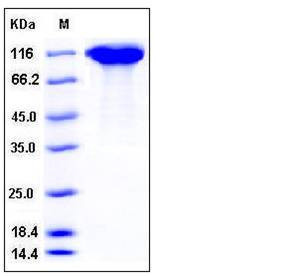Mouse LIFR / CD118 Protein (His Tag)
A230075M04Rik,AW061234,LIF
- 100ug (NPP3391) Please inquiry
| Catalog Number | P50423-M08H |
|---|---|
| Organism Species | Mouse |
| Host | Human Cells |
| Synonyms | A230075M04Rik,AW061234,LIF |
| Molecular Weight | The recombinant mouse LIFR consists of 796 amino acids and has a predicted molecular mass of 90 kDa. In SDS-PAGE under reducing conditions, the apparent molecular mass of rm LIFR is approximately 110-120 kDa due to glycosylation. |
| predicted N | Leu 44 |
| SDS-PAGE |  |
| Purity | > 95 % as determined by SDS-PAGE |
| Protein Construction | A DNA sequence encoding the extracellular domain of mouse LIFR (NP_038612.1) (Met 1-Ser 828) was expressed, with a polyhistidine tag at the C-terminus. |
| Bio-activity | 1. Measured by its ability to bind mouse LIF-Fc (P50755-M02H) in a functional ELISA. 2. Measured by its ability to inhibit the recombinant human LIF mediated inhibition in the M1 mouse myeloid leukemia cells. The ED50 for this effect is typically 5-20 ng/mL in the presence of 2 ng/mL recombinant human LIF. |
| Research Area | Neuroscience |Neurology process |Growth and Development |Neurotrophic Factor & Receptor |Other Neurotrophic Factors |
| Formulation | Lyophilized from sterile PBS, pH 7.4 1. Normally 5 % - 8 % trehalose, mannitol and 0.01% Tween80 are added as protectants before lyophilization. Specific concentrations are included in the hardcopy of COA. |
| Background | LIFR (leukemia inhibitory factor receptor) belongs to the family of cytokine receptors. LIFR forms a high-affinity receptor complex with gp130, which mediates the activity of LIF (leukemia inhibitory factor) and thus affects the differentiation, proliferation, and survival of a wide variety of cells in the adult and the embryo. Besides LIF, LIFR can also bind to and activate CNTF (ciliary neurotrophic factor) and CLC (cardiotrophin like cytokine). Evidence showed that in the retina, LIFR activating LIF, CT-1 and cardiotrophin like cytokine (CLC) are strongly upregulated in response to preconditioning with bright cyclic light leading to robust activation of signal transducer and activator of transcription-3 (STAT3) in a time-dependent manner. Further, blocking LIFR activation during preconditioning using a LIFR antagonist (LIF05) attenuated the induced STAT3 activation and also resulted in reduced preconditioning-induced protection of the retinal photoreceptors. These data demonstrate that LIFR and its ligands play an essential role in endogenous neuroprotective mechanisms triggered by preconditioning-induced stress. LIFR was newly found to be a suppressor of hepatocellular carcinoma (HCC), one of the world's top five causes of cancer-related deaths. |
| Reference |
